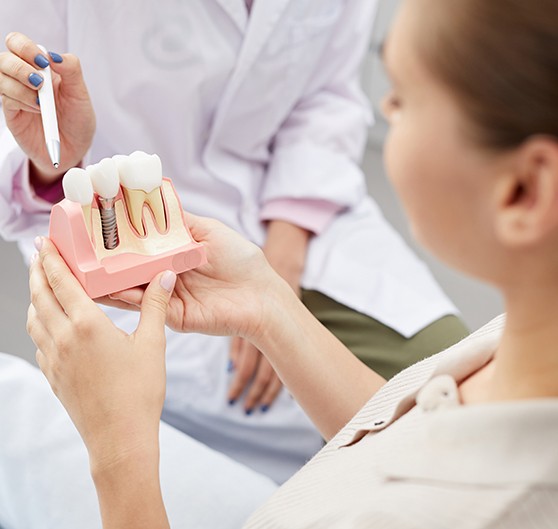Dental Implant Failure & Salvage – Norton Shores, MI
Protect Your Restored Smile from Dental Implant Failure
In recent years, dental implants have earned a stellar reputation for success, even in the long term. However, on some rare occasions, they can still fail. The good news is that if this happens it may be possible to restore your smile once again. Here’s how your dentist may be able to help get your smile back on track!

Why Do Dental Implants Fail?

There are many causes of dental implant failure, but the most common is a condition known as peri-implantitis. This occurs when bacteria and infection destroy the connective tissue around your dental implant, weaking the supporting jawbone structure. Peri-implantitis is often caused by poor oral hygiene and gum disease.
Additionally, dental implant failure could be caused by injury, failed osseointegration (where the dental implant fuses with the jawbone) or a variety of medical conditions.
Symptoms of a Failed Dental Implant

Though it can be more common early on, dental implant failure can occur at any time, even decades after your surgery. Early failure typically occurs during the healing period after placement, but without proper care, failure later is still possible. Here are a few warning signs that your dental implants could be in danger:
- Swelling and/or redness around the dental implant site.
- Oral pain or discomfort which intensifies instead of lessening.
- Chronic bad breath or a bad taste in the mouth.
- Receding gums around the implant site.
- Loose or moving dental implants.
- Changes in bite patterns.
How Dental Implant Salvage Works

If you are experiencing any of the above symptoms, or if something just doesn’t feel right with your dental implants, please reach out to us as soon as possible. The earlier dental implant failure is caught, the easier and less costly it typically is to treat.
After Dr. Ariel Heisser or Dr. Eric Heisser have had the opportunity to examine your dental implant, they will customize a treatment plan to get your mouth healthy enough to once again support your implant. This may include removing the current dental implant and reattaching it after treatment for any underlying issues. In some cases, you may require gum disease treatment, a bone graft, or a sinus lift.
Following the healing process from any preliminary procedures, your dentist will schedule your reimplantation procedure, after which you’ll follow the same aftercare instructions that you would for a new dental implant treatment. This will not only help protect your newly restored smile, but it will also help you prevent any future dental implant failure.
 (231) 737-2273
(231) 737-2273

 Appointment
Appointment